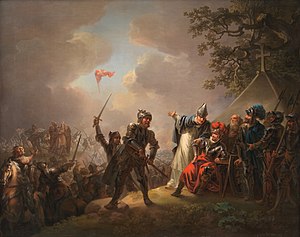 |
| Flag of Denmark "Dannebrog" by Per Palmkvist Knudsen |
The legend states the origin of the flag to the Battle of Lyndanisse, also known as the Battle of Valdemar (Danish: "Volmerslaget"), near Lyndanisse (Tallinn) in Estonia, on June 15, 1219.
The battle was going badly, and defeat seemed imminent. But then, right when the Danes were about to give up, the flag fell from heaven. Grasping the flag before it could ever touch the ground, the king took it in his hand, and proudly waved it in front of his discouraged troops, giving them hope, and leading them to victory.
The myth is clear. The flag, Dannebrog, was given to the Danes from God himself, and from that day forward, it was the flag of Denmark, and the Danish kings.
The battle was going badly, and defeat seemed imminent. But then, right when the Danes were about to give up, the flag fell from heaven. Grasping the flag before it could ever touch the ground, the king took it in his hand, and proudly waved it in front of his discouraged troops, giving them hope, and leading them to victory.
The myth is clear. The flag, Dannebrog, was given to the Danes from God himself, and from that day forward, it was the flag of Denmark, and the Danish kings.
No historical record supports this legend. The first record of the legend dates from more than 300 years after the campaign, and the first record connects the legend to a much smaller battle, though still in Estonia; the battle of Fellin (Viljandi) in 1208. Though no historical support exists for the flag story in the Fellin battle either, it is not difficult to understand how a small and unknown place is replaced with the much grander battle of Reval from the Estonia campaign of King Valdemar II.
This story originates from two written sources from the early 16th century:
This story originates from two written sources from the early 16th century:
The first is found in Christiern Pedersen's "Danske Krønike", which is a sequel to Saxo’s Gesta Danorum, written 1520 – 23. It is not mentioned in connection to the campaign of King Valdemar II in Estonia, but in connection with a campaign in Russia. He also mentions that this flag, falling from the sky during the Russian campaign of King Valdemar II, is the very same flag that King Eric of Pomerania took with him when he left the country in 1440 after being deposed as King.
The second source is the writing of the Franciscan monk Petrus Olai (Peder Olsen) of Roskilde, from 1527. This record describes a battle in 1208 near a place called "Felin" during the Estonia campaign of King Valdemar II. The Danes were all but defeated when a lamb-skin banner depicting a white cross falls from the sky and miraculously leads to a Danish victory. In another record by Petrus Olai called "Danmarks Tolv Herligheder" (Twelve Splendours of Denmark), in splendour number nine, the same story is re-told almost to the word; however, a paragraph has been inserted correcting the year to 1219.
Whether or not these records describe a truly old oral story in existence at that time, or a 16th century invented story, is not currently determined.
Some historians believe that the story by Petrus Olai refers to a source from the first half of the 15th century, making this the oldest reference to the falling flag.
It is believed that the name of the capital of Estonia, Tallinn, came into existence after the battle. It is derived from "Taani linn", meaning "Danish town" in Estonian. (According to Wikipedia)
 |
| The Danish Coat of Arms - First documented in the 1190s, modified 1819 |








No comments:
Post a Comment